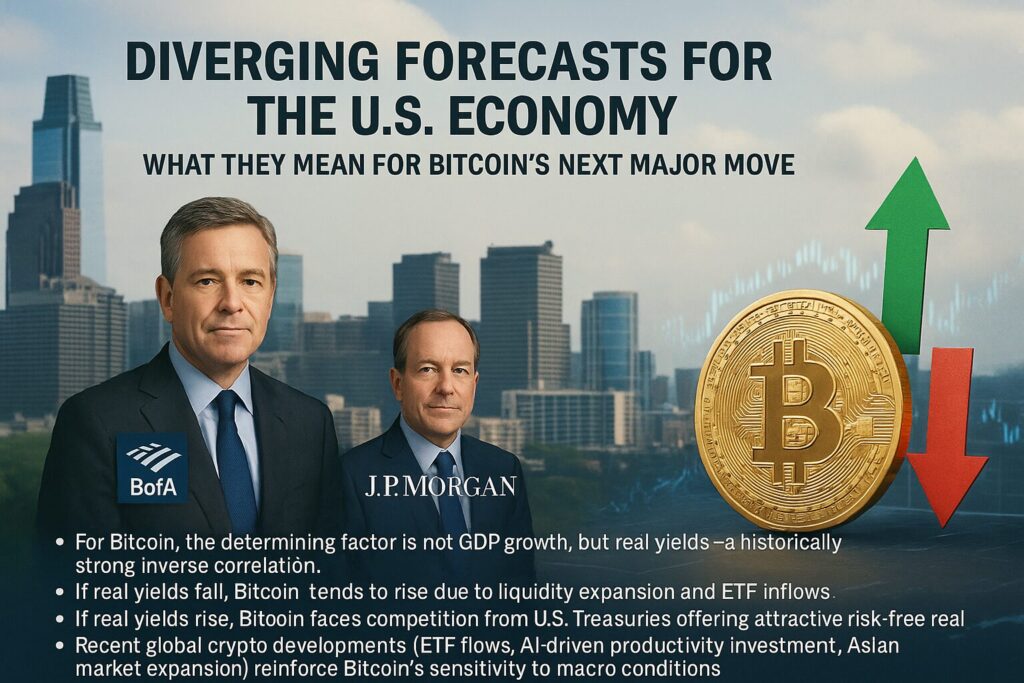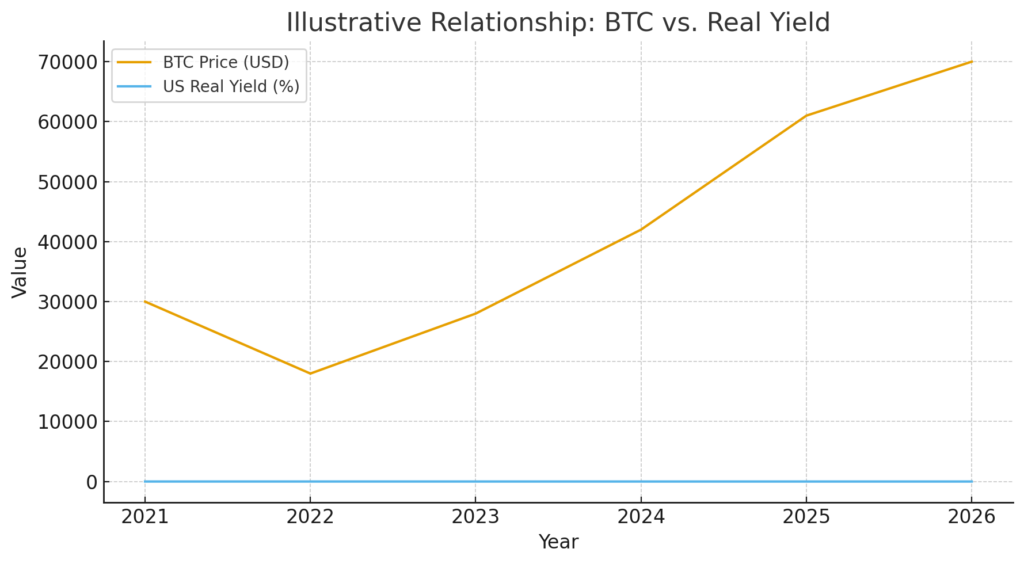
Main Points :
- Bank of America (BofA) forecasts strong U.S. GDP growth (2.4% in 2026) driven by fiscal stimulus, rate cuts, and AI-related capital investment.
- JP Morgan warns of persistent inflation, geopolitical tensions, tariff shocks, and political uncertainty that could keep real yields elevated.
- For Bitcoin, the determining factor is not GDP growth, but real yields—a historically strong inverse correlation.
- If real yields fall, Bitcoin tends to rise due to liquidity expansion and ETF inflows.
- If real yields rise, Bitcoin faces competition from U.S. Treasuries offering attractive risk-free real returns.
- Recent global crypto developments (ETF flows, AI-driven productivity investment, Asian market expansion) reinforce Bitcoin’s sensitivity to macro conditions.
- Investors exploring new revenue opportunities, new tokens, or practical blockchain applications must understand real yields as the single most important macro variable.
Introduction: A Split Outlook for 2026 and Why Bitcoin Investors Must Pay Attention
The U.S. economic outlook for 2026 is sharply divided between two major financial institutions—Bank of America (BofA) and JP Morgan. Their contrasting forecasts reveal not only competing macroeconomic expectations but also signal drastically different trajectories for global risk assets such as Bitcoin (BTC). While GDP numbers and fiscal projections make headlines, seasoned crypto investors know that the real driver of Bitcoin’s price is the level of real yields, not the headline growth rate.
Bitcoin’s price has historically exhibited a powerful inverse relationship with real yields:
- Low or falling real yields → Liquidity expansion → BTC tends to rise
- High or rising real yields → Competition from Treasuries → BTC faces downward pressure
This article synthesizes the recent forecasts, analyzes their implications for Bitcoin, incorporates global developments from other reputable sources, and provides a detailed picture tailored to investors seeking new crypto assets, new income opportunities, and real-world blockchain applications.
Section 1 — BofA’s Optimistic Scenario: Growth, AI Investment, and Easier Financial Conditions
Bank of America projects a 2.4% real GDP growth rate in 2026, driven by several reinforcing factors:
1. The OBBBA Fiscal Package
BofA expects the U.S. government’s fiscal package (OBBBA) to stimulate both household consumption and capital expenditure in the private sector. Fiscal expansion tends to reduce recession risk and support aggregate demand.
2. Monetary Policy Tailwinds
BofA anticipates Federal Reserve rate cuts, which would naturally reduce real yields once inflation expectations stabilize. Lower rates translate into:
- Cheaper credit
- Higher liquidity
- Improved risk appetite
- Increased ETF inflows into Bitcoin and other digital assets
3. Growth-Oriented Trade Policy
If the U.S. adopts a more growth-centric trade stance, supply chains may stabilize, reducing cost pressures and supporting lower inflation—again pushing real yields downward.
4. Persistent AI-Driven Investment
BofA highlights the structural rise in AI infrastructure investment as a multi-year driver of productivity and economic expansion. While this seems indirectly related to Bitcoin, AI-driven demand for compute resources and decentralized architectures can stimulate broader blockchain adoption.
Under this scenario, Bitcoin stands to benefit substantially. Liquidity expansion, combined with strong ETF inflows, mirrors the environment that propelled BTC beyond $60,000 in the early 2020s.
Section 2 — JP Morgan’s Caution: Inflation Risks and Geopolitical Tensions
JP Morgan, however, paints a different picture—one dominated by macro headwinds.
1. Tariff Revisions and Supply Shock Risks
Revisions to trade tariffs—especially those targeting China—could create supply-side inflation, pushing consumer prices higher and raising Treasury yields.
2. Rising Fiscal Deficits
Large and persistent federal deficits increase Treasury issuance, often lifting yields and turning real yields positive. This erodes Bitcoin’s attractiveness relative to safe assets.
3. U.S.–China Tensions
Geopolitical tensions intensify supply risks and raise long-term inflation expectations—again pushing real yields higher.
4. Labor Market Tightness
A tight labor market (higher wages, strong employment) keeps inflation elevated. Central banks respond with tighter monetary policy, not easing.
5. Political Uncertainty
The upcoming U.S. midterm elections introduce further uncertainty. Markets may demand higher yields to compensate for policy risk.
Under JP Morgan’s scenario, Bitcoin faces competition from U.S. Treasuries, which could offer real yields above 2–3%. Since Bitcoin offers no yield, this macro environment historically suppresses BTC price performance.
Section 3 — Why Real Yields, Not GDP, Are the True Driver of Bitcoin
Bitcoin’s price is not directly tied to GDP growth. Instead, it responds primarily to:
Real Yield = Nominal Yield – Inflation Expectations
This makes real yield the single most important macro factor for crypto investors.
Historical Relationship: An Inverse Correlation
- As real yields rose in 2022 (from near 0% to above 1.5%), BTC fell from $60,000 to $18,000.
- As real yields fell in 2023–2024, BTC rebounded dramatically.
- ETF inflows peaked during periods of falling real yields.
The logic is simple:
- Low real yield → Cash is unattractive → Investors seek alternative assets → BTC demand rises
- High real yield → Treasuries offer risk-free real returns → Liquidity shifts out of BTC

The graph visualizes the synthetic example of how Bitcoin and real yields move inversely.
Section 4 — ETF Flows: The Largest New Driver of Bitcoin Demand
Bitcoin is no longer driven primarily by retail speculation. Since the approval of multiple spot ETFs—including BlackRock’s IBIT—Bitcoin demand has institutionalized.
ETF Inflows Are Extremely Sensitive to Macro Conditions
- When real yields fall, ETFs experience sharp inflows.
- When real yields rise, ETF flows slow or reverse.
ETF products now serve as the primary channel for U.S. capital markets to enter Bitcoin, making macro conditions more influential than ever before.
Section 5 — Global Crypto Trends: Additional Context for Investors
Beyond the U.S. outlook, several global forces influence Bitcoin’s trajectory.
1. Asia’s Expanding Investor Base
Japan, South Korea, and the Philippines continue to expand crypto adoption frameworks. Their investors are highly sensitive to U.S. rate policies because USD liquidity still dominates global risk flows.
2. Stablecoin Infrastructure Growth
USDC, USDT, and new regional stablecoins deepen liquidity pools, making Bitcoin easier to trade and integrate into payments ecosystems.
3. Institutional Adoption Beyond ETFs
- Corporations increasingly hold BTC on balance sheets.
- Payment companies integrate BTC rails for cross-border settlement.
- Trading infrastructure for derivatives is expanding in Singapore, Japan, and Dubai.
These developments increase Bitcoin’s structural demand, but macro conditions still determine timing and magnitude.
Section 6 — Scenario Analysis: What Happens to Bitcoin Under Each Path?
Scenario A — BofA is Right (Real Yields Fall)
- BTC rallies strongly
- ETF inflows surge
- Liquidity boosts high-beta crypto assets
- Altcoins and new blockchain projects benefit
- Infrastructure tokens, AI-crypto integrations, and Layer 2 networks gain traction
Price trajectory in this environment historically aligns with major bull runs.
Scenario B — JP Morgan is Right (Real Yields Stay High)
- BTC stagnates or corrects
- ETF inflows slow significantly
- Capital rotates into U.S. Treasuries
- Risk appetite weakens
- Startups and altcoin projects face funding stress
This resembles the 2022 bear market environment.
Conclusion: The Path of Real Yields Will Define Bitcoin’s Fate
For investors exploring new crypto assets, next-generation blockchain utilities, or new income sources, understanding real yields is essential. The forecasts from BofA and JP Morgan illustrate two dramatically different paths for Bitcoin:
- BofA → Bullish macro environment → Lower real yields → BTC upside potential
- JP Morgan → Inflation risk and geopolitical instability → Higher real yields → BTC headwinds
In the coming year, monitoring real yields may be more important than tracking Bitcoin’s own on-chain metrics. As ETF dominance grows, Bitcoin becomes increasingly tied to macroeconomic forces, especially liquidity and Treasury market conditions.

